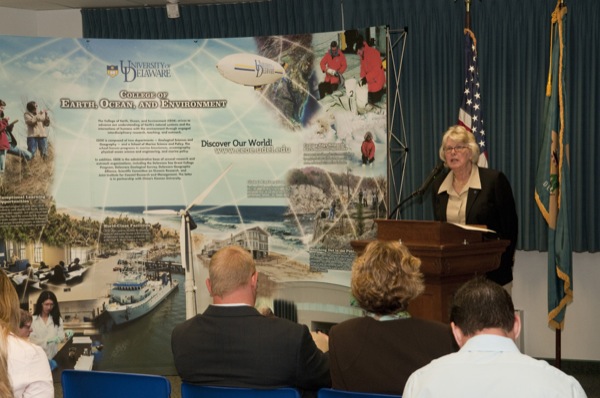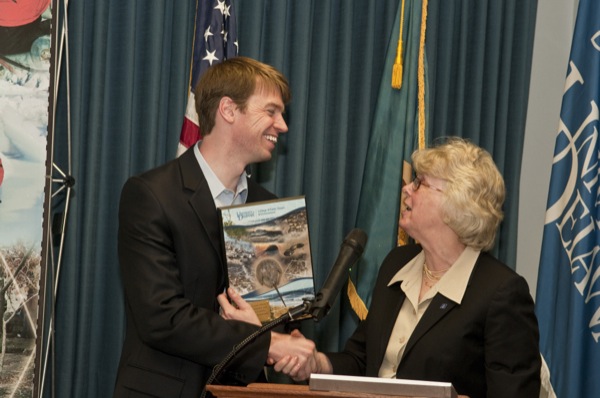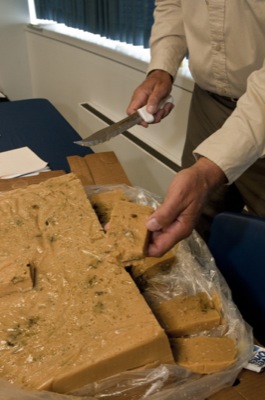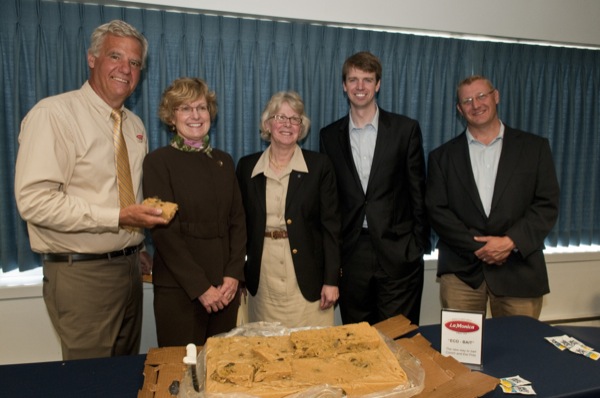

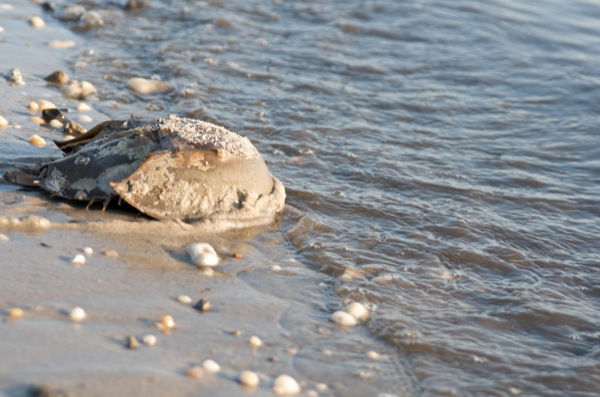
Bait alternative
New artificial bait could reduce number of horseshoe crabs used to catch eel, whelk
1:42 p.m., May 29, 2013--A new alternative bait product that will help reduce the number of horseshoe crabs harvested from the Delaware Bay has been introduced.
A team of University of Delaware researchers led by Nancy Targett, DuPont scientists, fisheries biologists, watermen and conservation groups were joined by Delaware Department of Natural Resources and Environmental Control (DNREC) Secretary Collin O’Mara to make the announcement on Wednesday morning, May 29, at UD’s Hugh R. Sharp Campus in Lewes.
Research Stories
Chronic wounds
Prof. Heck's legacy
For years, commercial eel and whelk fishers have dealt with a dilemma: They know the best bait to attract eel and whelk, locally known as conch, is a female horseshoe crab. However, harvest limits are in place to protect the Delaware Bay’s horseshoe crab population and the threatened migratory shorebirds that depend on their eggs as a food source. Commercial fishers have long worked within these limits, dividing each bait crab into pieces to bait multiple eel or whelk pots.
“Horseshoe crabs are an ecologically and economically important species in the Delaware Estuary, which hosts the largest concentrations of horseshoe crabs in the world,” said Gov. Jack Markell. “This alternative bait is the result of a great partnership among academic researchers, scientists, government, a private corporation and the commercial fisheries industry. By working together, they have found a solution that has great economic and environmental benefits, both now and for the future of bait development.”
“Conserving and restoring horseshoe crab populations is critical to supporting Delaware’s shorebird migration and implementing the vision of the Delaware Bayshore Initiative,” said O’Mara. “By using this new bait developed by leading scientists at the University of Delaware in partnership with DNREC, watermen will be able to reduce the number of horseshoe crabs used to catch whelk and eel, enjoy more convenient bait storage, help conserve the horseshoe crab population, and support migratory birds that depend on horseshoe crab eggs for food. I applaud my predecessor, Secretary John Hughes, and Dean Nancy Targett for their vision to launch this innovative effort, which will provide a win-win for both the economy and the environment for years to come.”
The new bait came after years of research, which was spurred in part by a surprising fact: Eel and whelk do not typically feed on adult horseshoe crabs in their natural environment, yet they find them hard to resist in baited pots.
That disconnect intrigued Targett, director of Delaware Sea Grant, dean of UD’s College of Earth, Ocean, and Environment and an ecologist who studies the chemical cues that influence animal behavior in the sea. She and her research team set out to identify the mysterious “scent” that lures in eels – and come up with a bait alternative to horseshoe crabs, which have experienced population declines in recent decades.
As a result of the research, Targett and her colleagues have developed a recipe for just such an artificial attractor that could help reduce the number of horseshoe crabs commercial fishermen use.
“Our hope is that this new bait will meet the fishing community’s needs and at the same time protect the horseshoe crab,” Targett said. “Delaware Sea Grant’s motto is ‘Science Serving the Delaware Coast,’ and we are grateful that so many partners shared in that spirit to move this project forward.”
Horseshoe crabs – which are actually more closely related to spiders than crabs – feed upon marine worms and small shellfish, and are fed upon by the federally threatened loggerhead sea turtle and a number of shark species. Their outer shells often support a whole community of marine life, from bacteria to blue mussels. Horseshoe crab eggs are a key part of the seasonal diet of at least seven commercially and recreationally important fish species and a host of crabs and other invertebrates.
Each May and June, horseshoe crabs lay large numbers of these small green eggs on Delaware Bay beaches. Migratory shorebirds, such as the endangered red knot, arrive around the same time to feast on surplus eggs before continuing their long journey from South America to their Arctic breeding grounds. In about two weeks, the birds double their weight for the final non-stop leg of the trip.
As horseshoe crab populations dropped considerably in the 1990s, so did the numbers of red knots. With the horseshoe crab decline largely attributed to their increased demand as bait in the commercial whelk pot fishery, the Atlantic States Marine Fisheries Commission (ASMFC) established a fisheries management plan with strict harvest quotas. Since the plan was adopted, increases have been noted in segments of the horseshoe crab population. Currently, the ASMFC plan allows for harvesting a limited number of male horseshoe crabs and no harvest of female crabs in Delaware.
With whelk as a popular seafood staple in Asia and an ingredient used domestically in chowders and fritters, demand for horseshoe crabs as bait continues to be high, particularly for female crabs, making an equally effective alternative appealing both economically and environmentally.
To reach the goal of finding an alternative bait, Targett partnered with DuPont scientists to analyze the horseshoe crab’s chemical makeup. They identified 100 compounds in tissue samples and were able to rule out some as key components in the scent that appeals so strongly to eel and whelk.
“We were pleased to provide the expertise of DuPont scientists, as well as business advice to make this project successful,” said Gary Spitzer, DuPont senior vice president of operations and engineering. “This is a great example of the way corporations, universities and governments can collaborate to promote sustainable solutions.”
Concurrent with the chemical approach, Targett’s lab developed artificial bait made from alginates (compounds found in brown seaweeds and kelp), a small amount of coarsely ground horseshoe crab and food-grade chemicals including baking soda and citric acid. When mixed together, these ingredients form a quick-set gelatin that keeps for up to four days.
Compared with using half of a female horseshoe crab, which is the Delaware limit, the mixture was just as productive in catching eel using only one-eighth of a female. By substituting an invasive species, the Asian shore crab, the researchers cut that amount down to as little as one-sixteenth of a horseshoe crab. They tested catching whelk with the bait and found similarly successful results.
In addition, despite speculation that female horseshoe crabs were better baits than males, the scientists found that artificial baits composed of males or females were equally effective. The Delaware limit is one whole male per trap or pot.
The bait research was funded by Delaware Sea Grant, DNREC and DuPont Chemicals and Fluoroproducts. A faculty member at the Delaware Biotechnology Institute participated in the early stages of the research. DNREC provided logistical assistance in obtaining horseshoe crab specimens and connecting researchers with fishers.
LaMonica Fine Foods in Millville, N.J., has started producing the bait commercially. Field tests in Delaware Bay with local whelk fishermen have been successful so far.
“The hallmark of this bait is that everyone wins,” said Jim Roussos of LaMonica Fine Foods LLC. “This is a major step in conserving the natural resource of horseshoe crabs. The conch and eel fishermen are relieved of the pressures of buying, storing and processing horseshoe crabs. The University of Delaware has proven once again that it is a vital, important and valuable institution not only to its students but to the public at large. And commercial fisheries win when we can be conservators of public resources while maintaining our historical way of life.”
To learn more about the project and download the recipe for personal use, visit the Delaware Sea Grant website.
For more information about pre-made bait, call Michael LaVecchia at LaMonica Fine Foods at 856-825-8111, ext. 102.
Photos by Lisa Tossey and Doug Baker




